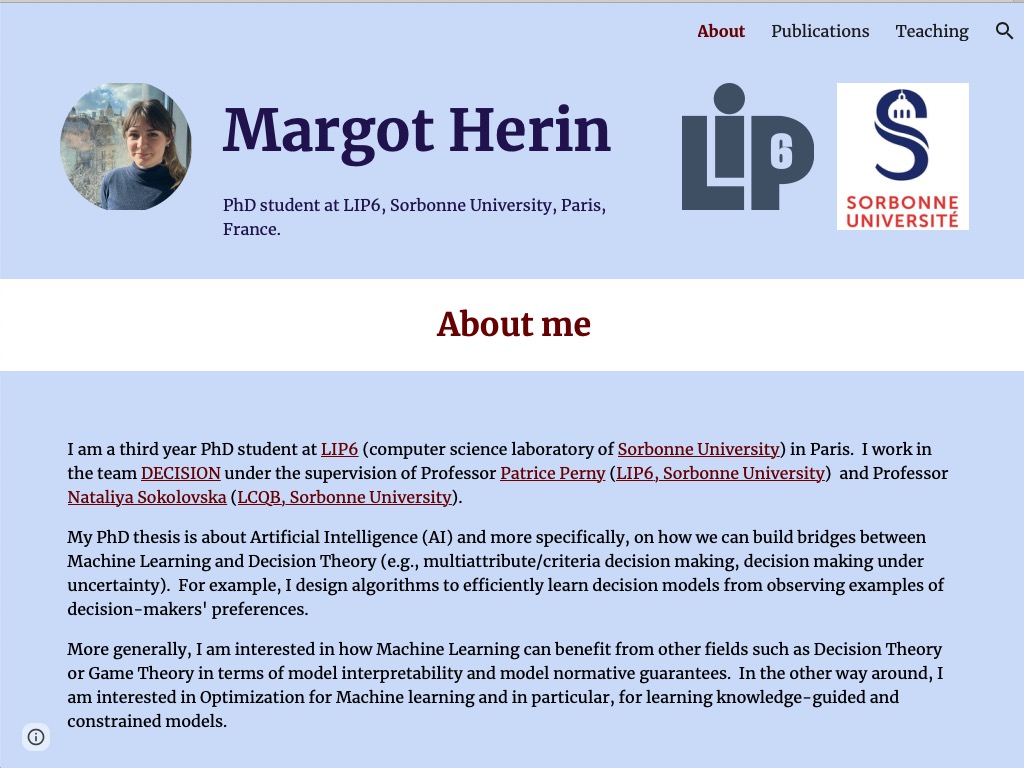HERIN Margot
Postdoc at Sorbonne UniversityTeam : DECISION
https://sites.google.com/view/margotherin/about
Supervision : Patrice PERNY
Co-supervision : SOKOLOVSKA Nataliya
Learning Preference Models: A Marriage between Decision Theory and Machine Learning
The work presented in this thesis lies at the intersection of decision theory and machine learning. The objective is to propose learning methods for preference models stemming from decision theory, with the aim of explaining or predicting a decision maker’s preferences.
We focus in particular on value function models that account for interactions between different viewpoints on the alternatives, such as the Choquet integral, the multilinear utility, and decomposable GAI utility functions. These models possess strong descriptive power, while also ensuring a form of rationality in preferences through the satisfaction of desirable mathematical properties, and allowing for interpretability via their parameters.
Due to the combinatorial nature of interactions, learning such models poses a computational challenge, as it requires determining an exponential number of parameters, sometimes subject to combinatorial constraints.
In this thesis, we propose to control the flexibility of these models through the learning of sparse representations of interactions, notably through the use of sparsity-inducing regularizations, and to reduce computational complexity by leveraging convex optimization methods from machine learning, suited to high-dimensional sparse learning problems. Then, this thesis contributes by :
- providing learning problem formulations tailored to various preference models and learning settings: from pre-collected examples (passive learning), from carefully selected queries (preference elicitation or active learning), or from a stream of examples (online learning),
- developing computationally efficient optimization algorithms to solve these problems, and
- conducting experimental evaluations on both synthetic and real-world preference data.
Phd defence : 06/20/2025
Jury members :
Yann Chevaleyre, Professeur, Université Paris Dauphine-PSL [Rapporteur]Michel Grabisch, Professeur, Université Paris 1 Panthéon-Sorbonne [Rapporteur]
Isabelle Bloch, Professeure, Sorbonne Université
Sébastien Destercke, Directeur de recherche au CNRS, Université de Technologie de Compiègne
Eyke Hüllermeier, Professeur, Ludwig-Maximilians-Universität München
Christophe Labreuche, Ingénieur de recherche, Thales Recherche et Technologie
Patrice Perny, Professeur, Sorbonne Université
Nataliya Sokolovska, Professeure, Sorbonne Université
Departure date : 08/31/2025
2022-2025 Publications
-
2025
- M. Herin : “Learning Preference Models: A Marriage between Decision Theory and Machine Learning”, thesis, phd defence 06/20/2025, supervision Perny, Patrice, co-supervision : Sokolovska, Nataliya (2025)
- M. Herin, P. Perny, N. Sokolovska : “Learning additive decompositions of multiattribute utility functions”, Theory and Decision, vol. 99, pp. 173-206, (Springer Verlag) (2025)
-
2024
- M. Herin, P. Perny, N. Sokolovska : “Learning preference representations based on Choquet integrals for multicriteria decision making”, Annals of Mathematics and Artificial Intelligence, vol. 92 (6), pp. 1511-1544, (Springer Verlag) (2024)
- M. Herin, P. Perny, N. Sokolovska : “Noise-Tolerant Active Preference Learning for Multicriteria Choice Problems”, Algorithmic Decision Theory, vol. 15248, Lecture Notes in Computer Science (LNAI), New Brunswick, NJ, United States, pp. 191-206, (Springer Nature Switzerland), (ISBN: 978-3-031-73903-3) (2024)
- M. Herin, P. Perny, N. Sokolovska : “Online Learning of Capacity-Based Preference Models”, Proceedings of the Thirty-third International Joint Conference on Artificial Intelligence (IJCAI-24), Jeju, Korea, Republic of (2024)
- M. Herin, M. Il Idrissi, V. Chabridon, B. Iooss : “Proportional marginal effects for global sensitivity analysis”, SIAM/ASA Journal on Uncertainty Quantification, vol. 12 (2), pp. 667-692, (ASA, American Statistical Association) (2024)
- M. Herin, P. Perny, N. Sokolovska : “Learning GAI-decomposable Utility Models for Multiattribute Decision Making”, Proc. 38th AAAI Conference on Artificial Intelligence (AAAI 2024), Vancouver, Canada (2024)
-
2023
- M. Herin, P. Perny, N. Sokolovska : “Learning Preference Models with Sparse Interactions of Criteria”, IJCAI 2023 - The 32nd International Joint Conference On Artificial Intelligence, Macao, China (2023)
-
2022
- M. Herin, P. Perny, N. Sokolovska : “A Dual Approach for Learning Sparse Representations of Choquet Integrals”, DA2PL From Multiple-Criteria Decision Aid to Preference Learning, Compiègne, France (2022)
- M. Herin, P. Perny, N. Sokolovska : “Learning Sparse Representations of Preferences within Choquet Expected Utility Theory”, Proceedings of the Thirty-Eighth Conference on Uncertainty in Artificial Intelligence, vol. 180, Proceedings of Machine Learning Research, Eindhoven, Netherlands, pp. 800-810, (PMLR) (2022)
- M. Herin, P. Perny, N. Sokolovska : “Learning Utilities and Sparse Representations of Capacities for Multicriteria Decision Making with the Bipolar Choquet Integral”, Multidisciplinary Workshop on Advances in Preference Handling, IJCAI, Vienne, Austria (2022)
